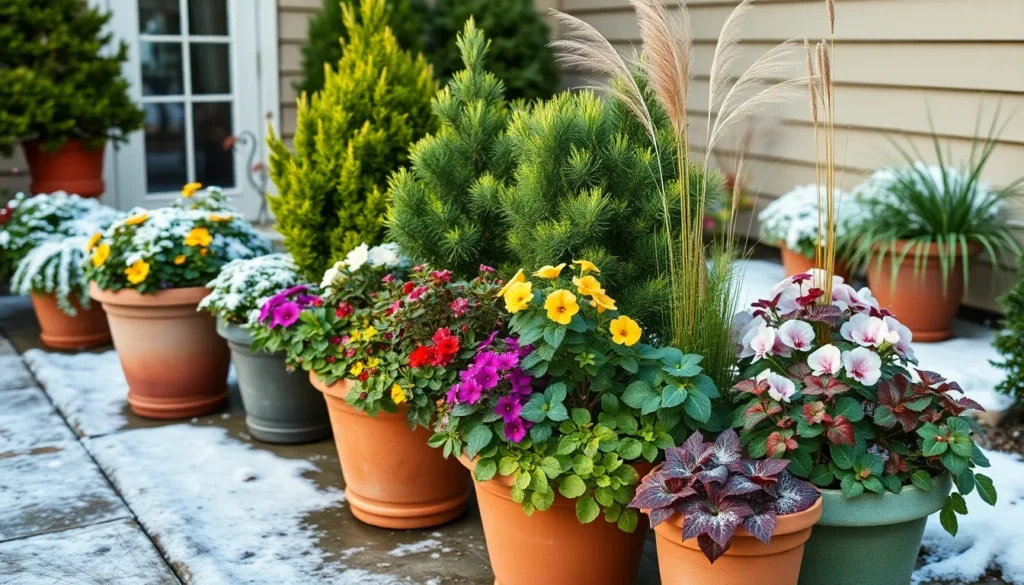Winter doesn’t have to mean empty, lifeless containers on your patio or deck. We’ve discovered that the right selection of cold-hardy plants can transform your outdoor space into a stunning winter wonderland that’ll have your neighbors asking for gardening advice.
Many gardeners mistakenly believe that outdoor container gardening ends when temperatures drop, but we’re here to prove them wrong. Hardy winter plants thrive in pots and can withstand freezing temperatures while delivering gorgeous colors, textures, and even winter blooms that brighten the darkest months.
From evergreen shrubs that provide year-round structure to colorful winter vegetables that offer both beauty and bounty, we’ll show you exactly which plants excel in outdoor containers during winter. You’ll learn which varieties can handle your climate zone and discover simple techniques that’ll keep your potted plants healthy through snow, ice, and bitter cold.
Choose Cold-Hardy Evergreens for Year-Round Structure
Cold hardy evergreens form the backbone of successful winter container gardens. We’ve found that these resilient plants maintain their beauty through freezing temperatures while providing essential structure when other plants go dormant.
Dwarf Conifers for Compact Spaces
Dwarf conifers deliver maximum impact in minimal space while tolerating temperatures down to -30°F in most varieties. Dwarf Alberta Spruce (Picea glauca ‘Conica’) grows slowly to just 4-6 feet tall, making it perfect for large containers on patios or entryways. Dwarf Balsam Fir (Abies balsamea ‘Nana’) stays compact at 2-3 feet and releases a pleasant evergreen fragrance during winter months.
Globe Blue Spruce (Picea pungens ‘Globosa’) forms a natural rounded shape without pruning and displays stunning blue-gray needles that catch winter sunlight beautifully. Mugo Pine (Pinus mugo) spreads horizontally rather than vertically, creating excellent groundcover effects in wide containers. These varieties require containers at least 18-24 inches wide to accommodate their root systems properly.
Boxwood Varieties for Classic Appeal
Boxwood varieties provide timeless elegance and exceptional cold tolerance down to -10°F when properly established. English Boxwood (Buxus sempervirens) maintains its deep green color throughout winter and responds well to light pruning for shape maintenance. Korean Boxwood (Buxus sinica var. insularis) handles colder climates better than other varieties and rarely suffers winter burn damage.
Winter Gem Boxwood (Buxus microphylla ‘Winter Gem’) specifically bred for cold climates retains excellent color even in harsh conditions. Green Velvet Boxwood (Buxus ‘Green Velvet’) stays naturally compact and dense without frequent trimming. We recommend using containers with good drainage since boxwood plants are particularly sensitive to waterlogged soil during winter freeze-thaw cycles.
Holly Plants for Festive Winter Berries
Holly plants bring vibrant berries and glossy foliage to winter containers while surviving temperatures as low as -20°F. Winterberry Holly (Ilex verticillata) produces brilliant red berries that persist through winter even after leaves drop in fall. Blue Princess Holly (Ilex × meserveae ‘Blue Princess’) keeps its dark green leaves year round and produces abundant red berries when paired with a male pollinator.
China Girl Holly (Ilex × meserveae ‘China Girl’) offers excellent cold hardiness and compact growth suitable for medium sized containers. Red Beauty Holly (Ilex × ‘Red Beauty’) displays exceptionally large bright red berries that create stunning winter focal points. Female holly varieties need male plants nearby for berry production, so we suggest planting both in separate containers placed within 50 feet of each other.
Select Colorful Winter Flowering Plants
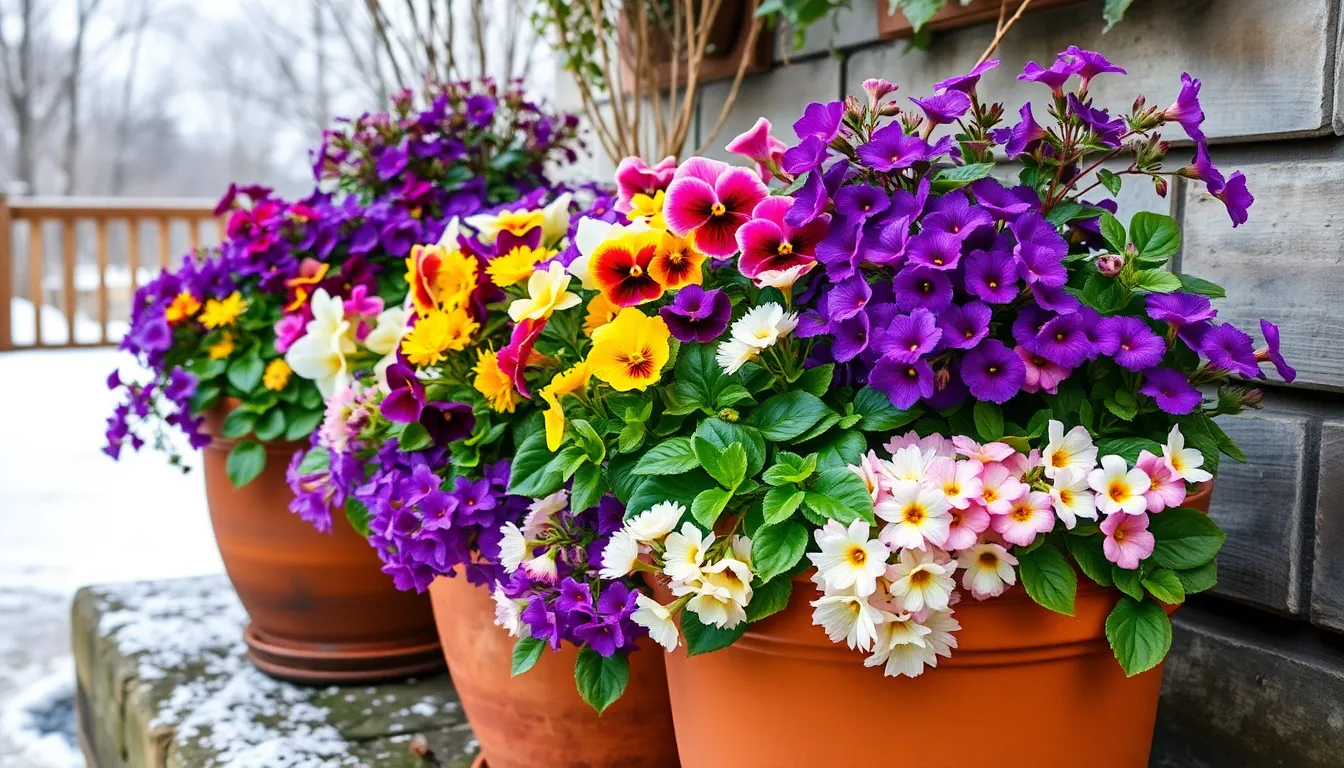
While evergreens provide structure, flowering plants bring vibrant color to transform your winter containers into cheerful displays. These hardy bloomers prove that winter gardening doesn’t mean sacrificing beauty for survival.
Pansies and Violas for Cheerful Blooms
Pansies stand out as the champions of winter container gardening, surviving freezing temperatures while delivering those beloved “smiling face” flowers in brilliant colors. We love how these resilient beauties bounce back vigorously when summer returns, making them excellent long term investments for your outdoor pots. Their pleasant fragrance adds an unexpected sensory bonus during those brief winter warm spells.
Growing pansies successfully requires normal potting soil mixed with general purpose fertilizers to keep them nourished throughout the cold months. Deadheading faded flowers becomes crucial for continuous blooming, while ample sun exposure ensures they’ll produce those cheerful displays we’re after. Regular watering prevents the most common pansy problem – underwatering – which can quickly damage these otherwise hardy plants.
Violas offer similar winter hardiness with their own charming personality, closely related to pansies but with smaller, more delicate faces. These compact bloomers work beautifully in mixed arrangements, providing reliable color when most other flowers have given up for the season.
Winter Blooming Heather for Purple Accents
Winter heather transforms ordinary containers into elegant displays with its delicate purple flowers that emerge during the coldest months. This hardy shrub brings subtle sophistication to winter arrangements, creating natural looking compositions that feel both refined and organic.
The texture contrast heather provides works especially well when paired with broader leafed plants or structural evergreens. We appreciate how this low maintenance option delivers consistent purple accents without demanding constant attention during harsh weather conditions.
Cyclamen for Delicate Pink and White Flowers
Cyclamen enchants with butterfly like flowers that dance above heart shaped foliage in soft shades of pink and white throughout winter. These refined bloomers prefer cool temperatures and partial shade, making them perfect companions for north facing patios or covered outdoor areas.
Their preference for shaded to partially sunny spots means cyclamen can brighten those difficult areas where other flowering plants struggle. We find their delicate appearance creates beautiful focal points in winter planters, adding sophisticated charm that complements rather than competes with bolder flowering neighbors.
Incorporate Winter Vegetables and Herbs
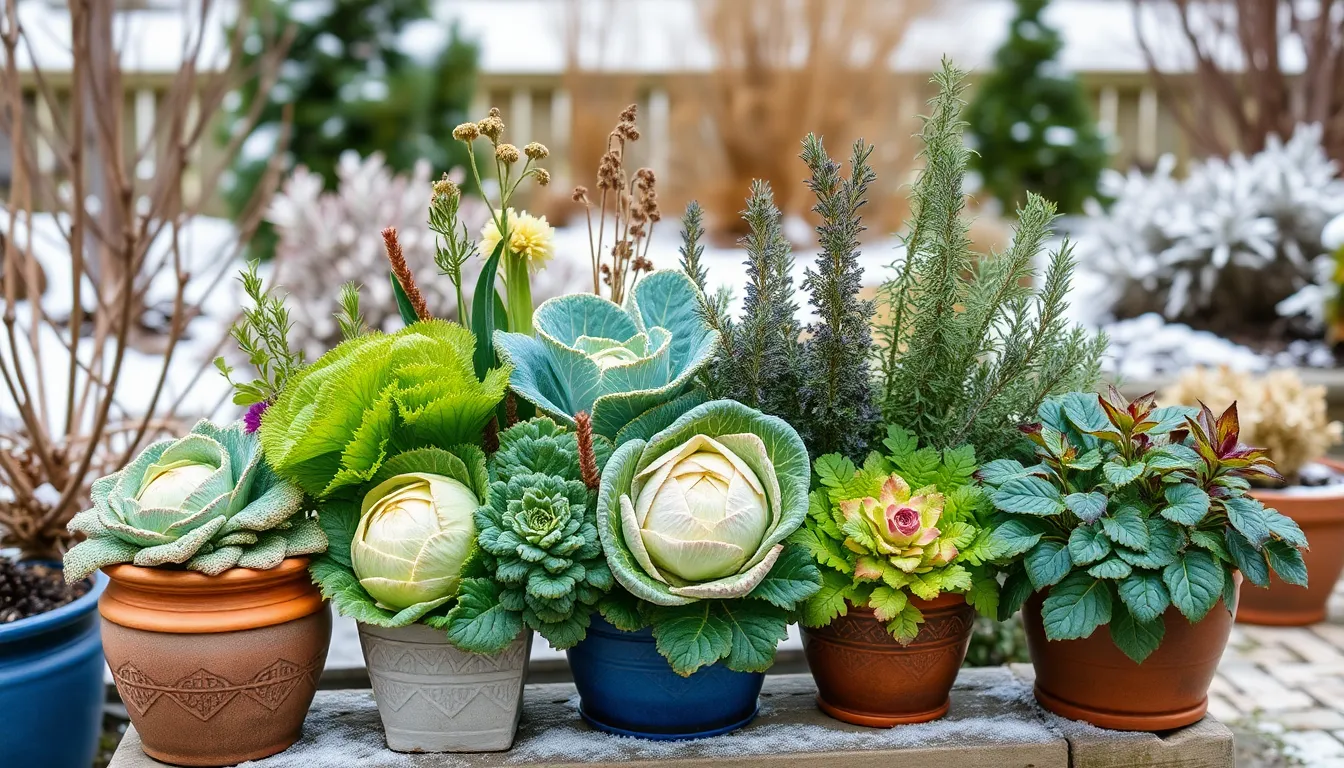
Winter containers can serve a dual purpose by combining visual appeal with fresh produce. We’ll transform ordinary outdoor pots into productive edible gardens that thrive throughout the coldest months.
Kale and Cabbage for Edible Beauty
Kale varieties offer exceptional cold tolerance while providing striking colors from deep purple to vibrant green in our winter containers. These leafy vegetables actually improve in flavor after frost exposure, making them perfect for outdoor pot cultivation. Cabbage heads add substantial structure to arrangements with their rounded forms and blue-green foliage that complements other winter plants beautifully.
We recommend planting ornamental kale alongside traditional varieties like ‘Winterbor’ and ‘Red Russian’ for maximum visual impact. Cabbage cultivars such as ‘January King’ and ‘Savoy’ create focal points with their dense, sculptural heads. Both vegetables require frostproof containers with excellent drainage and quality potting soil to maintain healthy root systems during temperature fluctuations.
Winter Herbs Like Rosemary and Thyme
Rosemary brings evergreen texture and aromatic fragrance to our winter herb containers while tolerating temperatures well below freezing. This hardy perennial maintains its needle-like foliage year-round, providing consistent visual interest alongside its culinary benefits. Thyme varieties spread as attractive ground cover while offering fresh herbs for winter cooking.
Positioning these herbs in sheltered, sunny locations protects them from harsh winds and excessive moisture that can damage roots. We water sparingly during winter months, allowing soil to dry between waterings to prevent root rot. Fertilizing should stop completely until spring arrives, as new growth would be vulnerable to frost damage.
Cold-Season Root Vegetables in Containers
Root vegetables like carrots, radishes, and beets adapt surprisingly well to container growing when we provide adequate space and proper conditions. Deeper pots accommodate root development while offering better insulation against freezing temperatures. We select containers at least 12 inches deep for carrots and 8 inches for radishes to ensure proper growth.
Burying containers partially in the ground or grouping them together creates beneficial microclimates that extend the growing season. High-quality potting mixes with excellent drainage prevent waterlogging that destroys root systems in cold conditions. Regular watering continues until soil freezes, then we stop completely to avoid root damage from ice formation.
| Vegetable Type | Minimum Container Depth | Cold Tolerance | Harvest Time |
|---|---|---|---|
| Carrots | 12 inches | Down to 20°F | 70-80 days |
| Radishes | 8 inches | Down to 25°F | 30-45 days |
| Beets | 10 inches | Down to 15°F | 55-70 days |
| Kale | 8 inches | Down to 10°F | 50-65 days |
| Cabbage | 12 inches | Down to 20°F | 80-100 days |
Add Ornamental Grasses for Texture and Movement
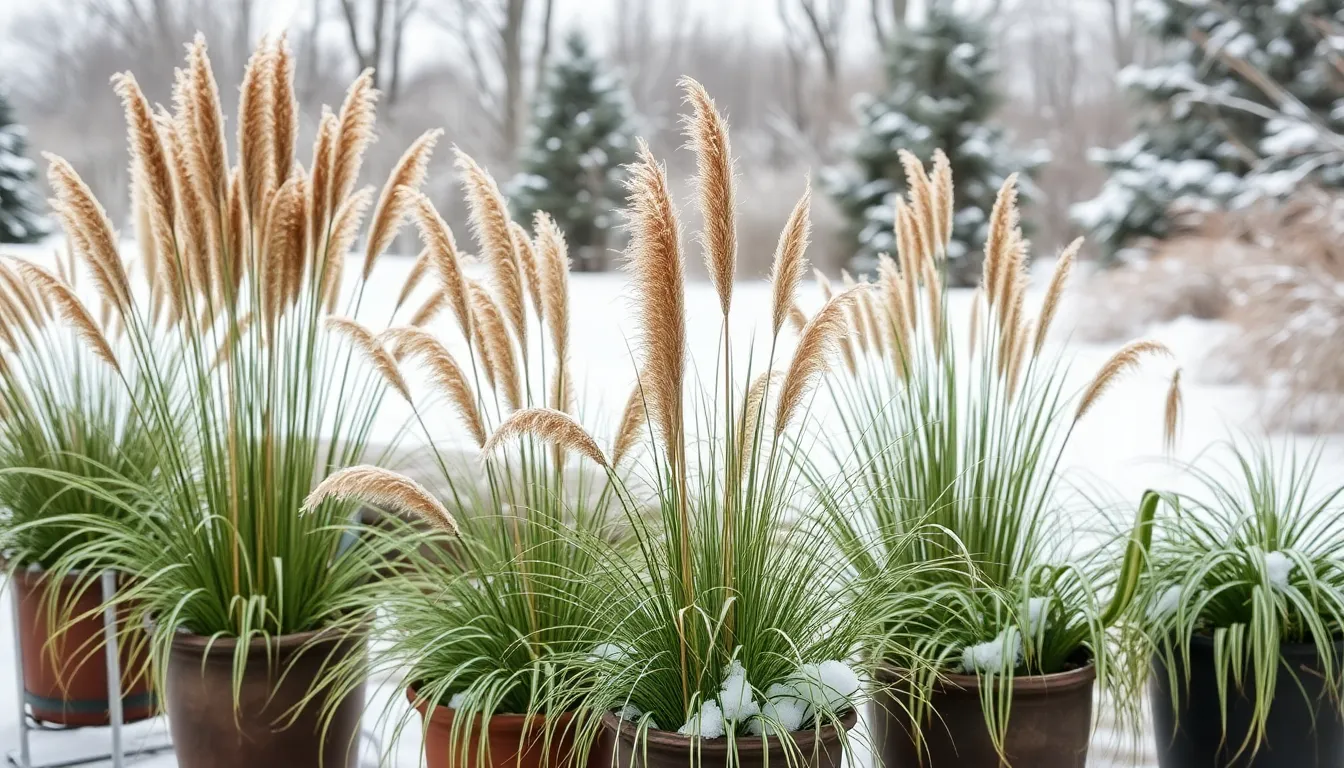
Ornamental grasses bring ever-changing motion and structure to winter containers when many other plants have gone dormant. These versatile plants offer excellent texture, movement, and low maintenance requirements that make them perfect companions for our winter evergreens and flowering plants.
Fountain Grass for Graceful Winter Form
Fountain grass (Pennisetum species) creates elegant, arching foliage that adds sophisticated movement to our winter containers. These popular grasses produce soft, feathery flower spikes that persist throughout winter, maintaining their graceful form even after the plant dies back. We recommend leaving the striking winter silhouette intact until early spring, as it provides valuable wildlife cover and continues adding visual interest to our outdoor displays.
Container grown fountain grass works exceptionally well because its flowing texture complements the structured forms of evergreen shrubs and the bright colors of winter flowers. The graceful arching habit creates beautiful contrast against upright conifers while softening the edges of rectangular or square containers.
Sedges for Low-Maintenance Ground Cover
Sedges (Carex species) provide evergreen or semi-evergreen foliage that works beautifully as ground cover in our winter containers. These grass-like plants adapt to various light and moisture conditions, making them incredibly reliable for winter pot gardening. We find sedges particularly valuable because they require minimal maintenance while delivering consistent texture throughout the cold months.
Different sedge varieties offer unique foliage colors, from deep green to bronze and even variegated patterns that brighten winter arrangements. Their clumping growth habit makes them perfect for filling spaces between larger plants or creating layered compositions in deeper containers.
Ornamental Wheat for Architectural Interest
Ornamental wheat delivers strong vertical lines and bold architectural elements that anchor our winter container designs. These grasses produce tall seed heads and rigid stems that provide essential height and structure, creating striking focal points in our arrangements. We use ornamental wheat to complement softer grasses like fountain grass and sedges, building ever-changing compositions with varied textures and forms.
The wheat’s upright growth habit works particularly well in large containers or galvanized tubs, where it has adequate root space to develop its full architectural potential. These sturdy stems maintain their structure throughout winter, adding rustic charm while creating backbone for our seasonal displays.
Include Berry-Producing Shrubs for Wildlife Appeal
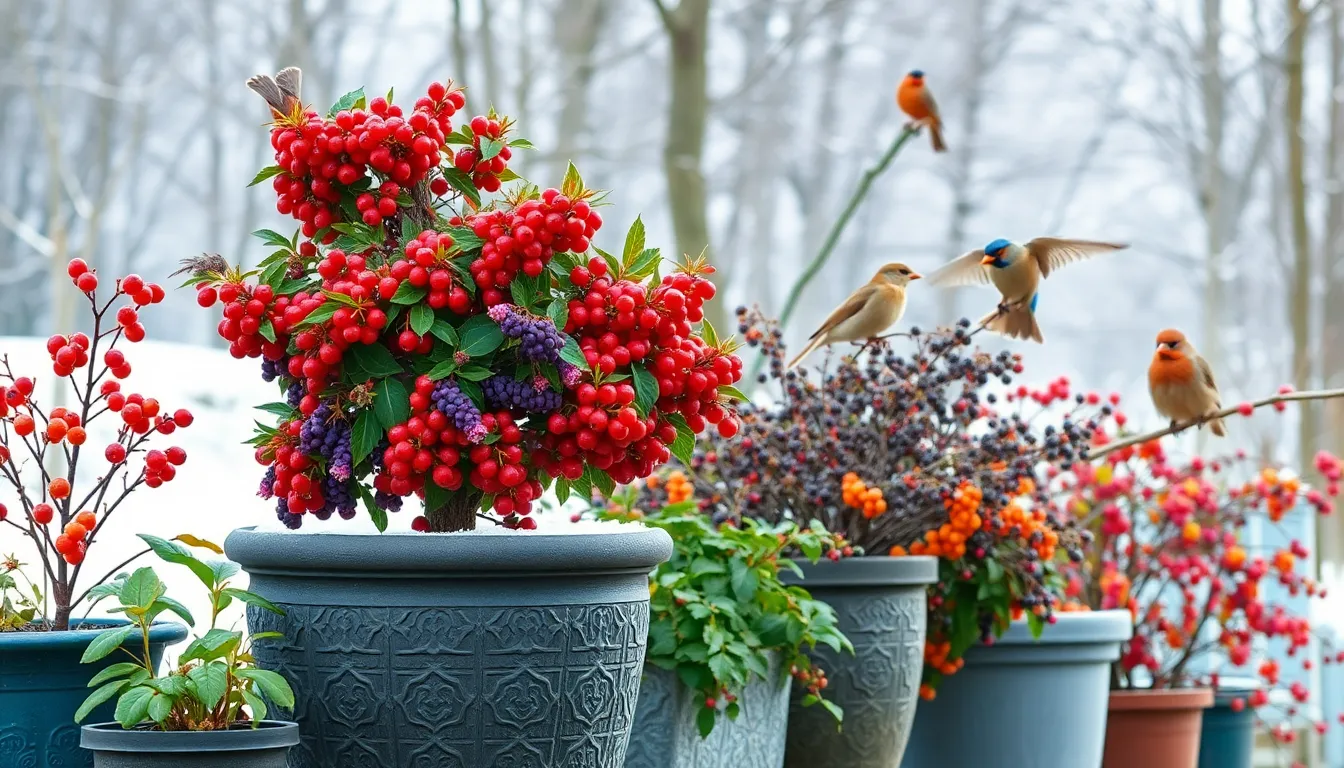
Berry producing winter shrubs transform ordinary outdoor containers into vibrant wildlife sanctuaries while adding spectacular seasonal color. These hardy plants offer the perfect complement to evergreens and flowering plants, creating ever-changing winter displays that benefit both your garden’s aesthetics and local bird populations.
Winterberry Holly for Bright Red Berries
Winterberry Holly (Ilex verticillata) produces stunning bright red berries that persist from fall through winter, creating dramatic focal points when other plants fade. This deciduous holly thrives in containers with sun to part shade exposure and tolerates challenging conditions including salt and wet environments.
Pollination requirements make planning essential since both male and female plants must be present for berry production. We recommend planting one male Winterberry Holly for every three to five female plants to ensure abundant fruit development.
Wildlife attraction reaches its peak during winter months when birds rely on these nutritious berries for sustenance. The glossy red fruits remain vibrant against bare winter branches, offering exceptional ornamental value while supporting local ecosystems through cold weather periods.
Beautyberry for Purple Fruit Clusters
Beautyberry (Callicarpa spp.) showcases clusters of vivid purple berries that create unique color combinations in winter container arrangements. These distinctive fruits persist well into winter months, providing both striking visual interest and valuable wildlife nutrition.
Container adaptation makes Beautyberry an excellent choice for outdoor pots since it responds well to confined growing conditions. The shrub’s compact growth habit suits various container sizes while delivering maximum ornamental impact through its unusual purple berry clusters.
Wildlife benefits extend throughout winter as birds discover this reliable food source during scarce months. Purple berry clusters stand out dramatically against winter landscapes, offering gardeners an uncommon color option that enhances diverse container combinations.
Cotoneaster for Long-Lasting Orange Berries
Cotoneaster species deliver exceptional winter performance with orange to red berries that persist through fall and winter seasons. Popular varieties include Shiny Cotoneaster and Peking Cotoneaster, both featuring glossy leaves that transform to red or purple autumn colors before berry display peaks.
Evergreen characteristics provide year round foliage structure plus to colorful winter berries, making Cotoneaster valuable for multi season container interest. These shrubs maintain their leaves through winter in most climates, offering consistent green backdrop for bright orange fruit displays.
Pruning tolerance allows for shaped container presentations since Cotoneaster responds well to trimming and maintenance. Wildlife attraction includes both birds and butterflies, though berries remain mildly toxic to humans while providing essential nutrition for outdoor creatures.
Container growing success depends on proper drainage and appropriate pot sizing to accommodate root development. We’ve found that Cotoneaster thrives in containers when given adequate space and regular watering schedules throughout winter months.
Choose Winter-Blooming Bulbs for Early Spring Preview
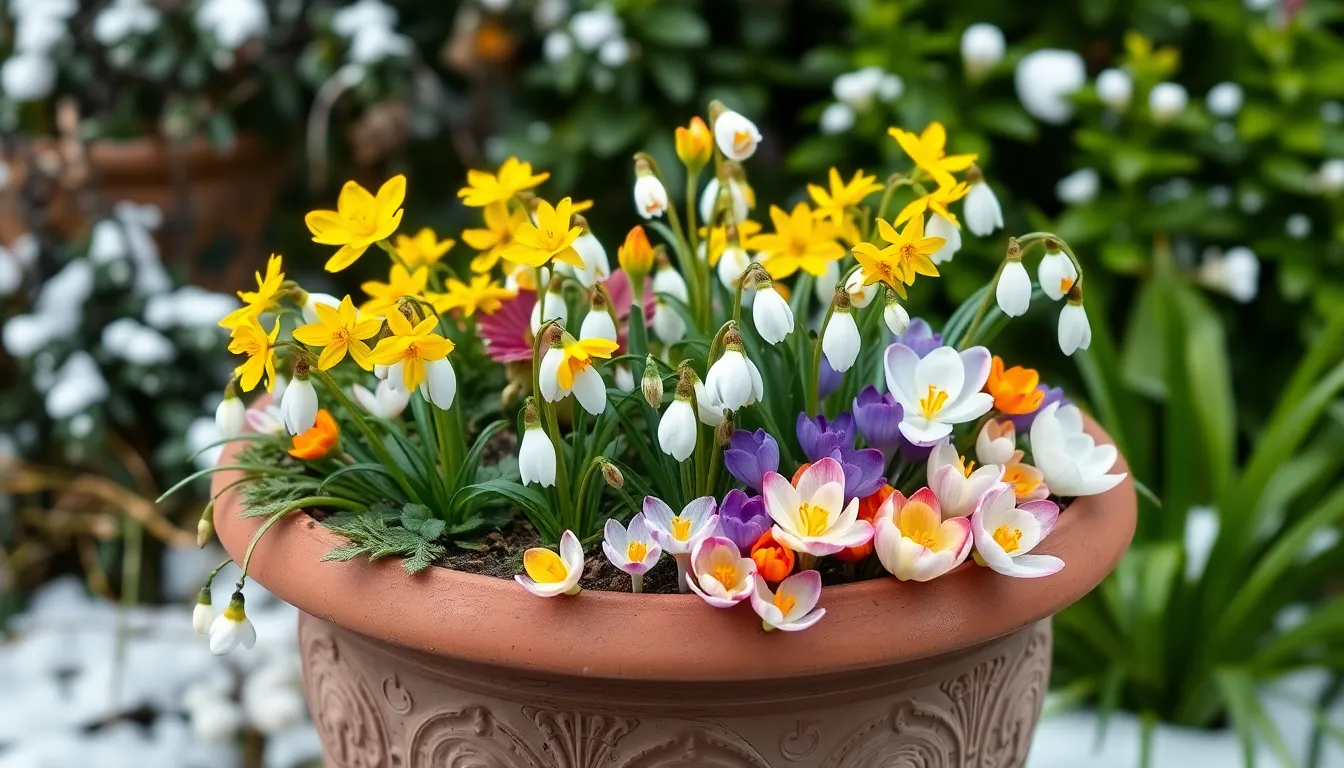
Winter blooming bulbs transform outdoor containers into cheerful displays when planted correctly in fall. These hardy perennials emerge through snow and frost to deliver the first glimpses of spring color during late winter months.
Winter Aconite for Golden Yellow Flowers
Winter aconite produces bright golden yellow flowers about 3 cm across that sit atop lush green bracts. The cheerful blooms open only in sunshine, creating dramatic splashes of color during gray winter days. Plant these tuberous bulbs in fall when soil temperatures drop to around 60°F (15°C) or lower for optimal establishment.
Soaking the bulbs in water for 24 hours before planting prevents desiccation and significantly improves success rates. Position containers in full sun or partial shade locations where they’ll receive adequate spring sunlight. Winter aconites naturalize by seeding freely, expanding their coverage year by year while remaining deer resistant and pollinator friendly.
Snowdrops for Pure White Early Blooms
Snowdrops deliver delicate, pure white nodding flowers that rank among the earliest bloomers of the season. These relatives of daffodils resist rodent damage, making them reliable choices for outdoor containers. Galanthus elwesii varieties perform exceptionally well in drier conditions and bloom earlier than other snowdrop types.
Plant snowdrop bulbs in well-drained soil during fall to ensure proper cold stratification. Position containers where they’ll receive cooler temperatures and adequate moisture without waterlogging. The elegant white flowers create stunning contrasts against winter’s stark industry while signaling spring’s arrival.
Crocus Varieties for Colorful Ground Coverage
Crocus bulbs offer vibrant color ranges that create spectacular ground coverage displays in outdoor containers. Plant these hardy bulbs in fall, several weeks before ground freezing begins. They thrive in well-drained soil with full to partial sun exposure throughout winter months.
Layer crocus varieties alongside winter aconites and snowdrops for ever-changing multi-colored effects. The combination creates golden yellow, pure white, and multicolor displays that brighten dreary winter spaces. These naturalizing perennials return year after year, providing reliable early spring previews that extend from late winter into early spring months.
Select Succulent Plants for Low-Maintenance Winter Care
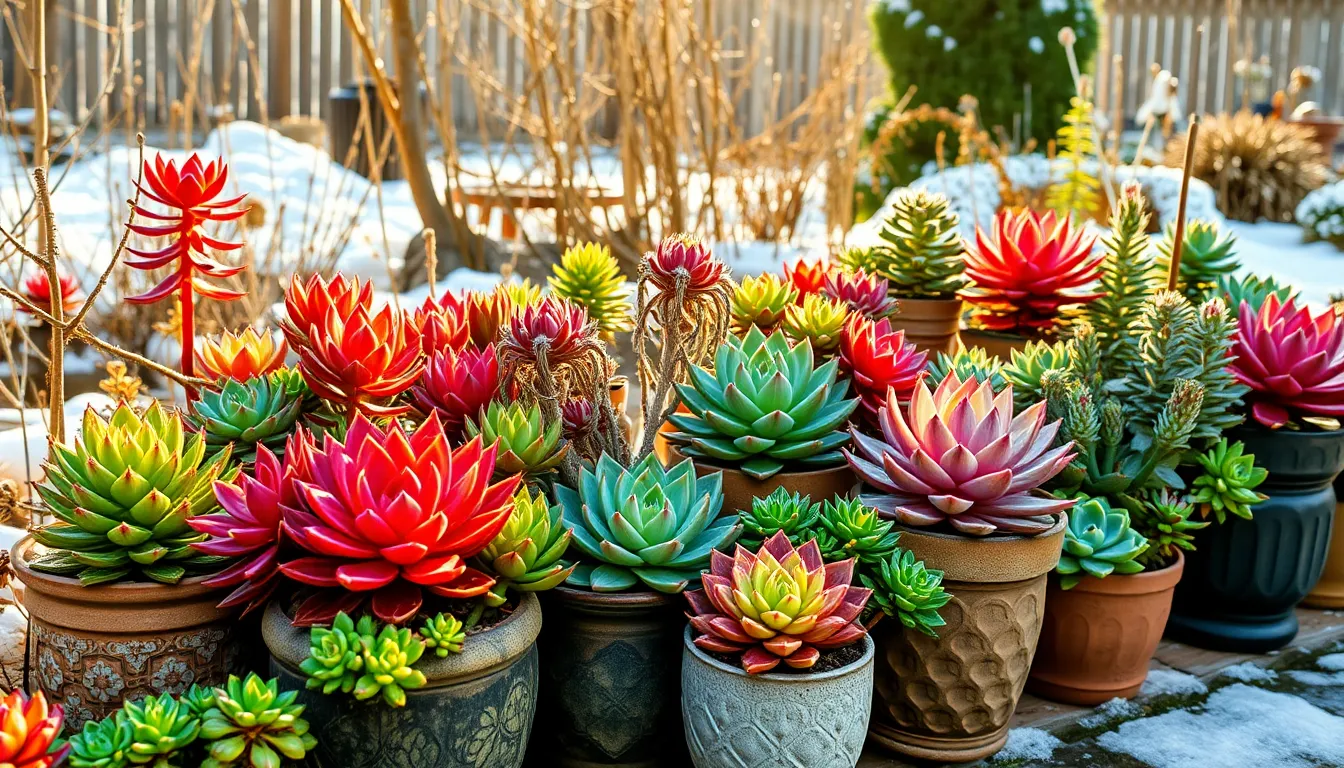
Succulents offer exceptional winter performance in outdoor containers by requiring minimal watering and tolerating cooler temperatures better than most plants. Their fleshy leaves store water naturally, reducing maintenance needs during dormant winter months.
Hens and Chicks for Cold-Tolerant Rosettes
Hens and Chicks (Sempervivum spp.) deliver outstanding cold tolerance with their compact rosette formations that thrive in winter containers. We recommend these hardy succulents for their ability to survive in USDA zones down to zone 3 or 4, withstanding frost and snow without damage. Their tight rosette clusters create attractive textural interest while handling freezing temperatures better than most succulent varieties.
Clusters form naturally as “mother” plants produce smaller “chick” rosettes around their base. Drainage becomes critical for these plants since waterlogged soil can cause root rot during freeze thaw cycles. Position containers in sunny to partly sunny locations where they’ll receive adequate light throughout winter months.
Sedum Varieties for Interesting Leaf Textures
Sedum species provide remarkable diversity in leaf textures and colors that enhance winter container displays. Many cultivars survive below freezing temperatures with minimal damage, making them reliable choices for harsh winter conditions. Their adaptability allows gardeners to mix them successfully with other winter hardy plants in outdoor arrangements.
Varieties range from low growing groundcover types to upright forms with different leaf shapes and seasonal color changes. Some sedums develop bronze or reddish tints during cold weather, adding unexpected color to winter pots. Their drought tolerance means less frequent watering during winter months when many plants enter dormancy.
Jade Plants for Indoor-Outdoor Flexibility
Jade plants (Crassula ovata) offer unique versatility for winter container gardening in mild climates where they can remain outdoors year round. We find they’re moderately frost hardy when temperatures don’t drop below 30°F for extended periods. Their bright light requirements and well drained soil needs align perfectly with proper winter container care practices.
Portability becomes their greatest advantage in colder regions where gardeners can move pots indoors during extreme cold spells. Their thick, glossy leaves maintain attractive appearance throughout winter months while requiring minimal water. Indoor overwintering allows gardeners in harsh climates to enjoy these classic succulents without losing their investment to freezing temperatures.
Conclusion
Winter container gardening opens up endless possibilities for creating stunning outdoor displays that defy the season’s harsh reputation. We’ve shown you that with the right plant selections—from hardy evergreens and colorful bloomers to productive vegetables and striking ornamental grasses—your pots can remain vibrant throughout the coldest months.
The key to success lies in choosing plants that naturally thrive in winter conditions and providing them with proper containers and care. Whether you’re drawn to the architectural beauty of dwarf conifers the cheerful faces of pansies or the practical appeal of fresh winter herbs there’s a perfect combination waiting for your outdoor space.
Don’t let winter limit your gardening passion. Start planning your cold-season containers now and discover how rewarding it can be to maintain beautiful productive gardens year-round.
Frequently Asked Questions
What plants can survive in winter containers?
Cold-hardy plants that thrive in winter containers include evergreen shrubs like dwarf conifers, boxwood, and holly; winter flowering plants such as pansies, violas, and heather; winter vegetables like kale and cabbage; hardy herbs including rosemary and thyme; ornamental grasses like fountain grass and sedges; berry-producing shrubs such as winterberry holly; winter-blooming bulbs like snowdrops and crocus; and cold-tolerant succulents including hens and chicks.
How do I choose the right container for winter gardening?
Select containers that are frost-proof and have excellent drainage holes to prevent water from freezing and damaging roots. Choose appropriately sized pots – larger containers provide better insulation for roots and hold more soil, which helps regulate temperature. Ensure containers are deep enough for root vegetables (at least 12 inches) and wide enough to accommodate the mature size of your chosen plants.
Can I grow vegetables in containers during winter?
Yes, many cold-tolerant vegetables thrive in winter containers. Kale, cabbage, carrots, radishes, and beets are excellent choices that actually improve in flavor after frost exposure. Use containers at least 12 inches deep for root vegetables and ensure proper drainage. Plant ornamental kale varieties for both visual appeal and edibility. These vegetables can provide fresh produce throughout the colder months.
Do winter container plants need special care?
Winter container plants require minimal but important care. Ensure proper drainage to prevent root rot from frozen water. Water sparingly when soil is dry but not frozen. Deadhead spent flowers on blooming plants. Protect containers from extreme temperature fluctuations by grouping them together or moving them to sheltered locations. Most cold-hardy plants are low-maintenance once established.
When should I plant winter containers?
Plant winter containers in fall before the first hard frost. This timing allows plants to establish their root systems before winter stress. Winter-blooming bulbs should be planted in fall for spring emergence. Some plants like pansies and violas can be planted throughout fall and will continue blooming intermittently through winter, providing color during milder periods.
What are the best evergreen plants for winter containers?
The best evergreen plants for winter containers include dwarf conifers like Dwarf Alberta Spruce and Dwarf Balsam Fir, which provide structure and year-round color. Boxwood varieties offer classic appeal with excellent cold tolerance. Holly plants add festive winter berries and glossy foliage. These evergreens require minimal maintenance while providing essential structure and beauty throughout the winter months.
Can succulents survive in winter containers?
Yes, many succulents are surprisingly cold-hardy and perfect for winter containers. Hens and Chicks (Sempervivum) can tolerate freezing temperatures and require minimal watering. Various sedum varieties offer diverse textures and colors while withstanding cold. Jade plants can survive outdoors in mild winter areas or be moved indoors during extreme cold. Their low water requirements make them ideal for winter gardening.
How do ornamental grasses enhance winter containers?
Ornamental grasses add texture, movement, and architectural interest to winter containers when other plants are dormant. Fountain grass provides elegant, arching foliage with persistent flower spikes. Sedges offer low-maintenance evergreen ground cover. Ornamental wheat creates strong vertical lines and focal points. These grasses are extremely low-maintenance and provide dynamic visual appeal throughout winter while requiring minimal care.

